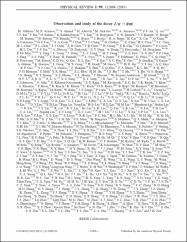Observation and study of the decay J/psi -> phi eta eta '

View/
Access
info:eu-repo/semantics/openAccessAttribution 3.0 United Stateshttp://creativecommons.org/licenses/by/3.0/us/Date
2019Metadata
Show full item recordCitation
Ablikim, M., Achasov, M. N., Ahmed, S., Albrecht, M., Alekseev, M., Amoroso, A., . . . Collaboration, B. (2019). Observation and study of the decay J/psi -> phi eta eta '. Physical Review D, 99(11), 10. doi:10.1103/PhysRevD.99.112008Abstract
We report the observation and study of the decay J/psi -> phi eta eta' phi eta eta' using 1.3 x 10(9) J/psi events collected with the BESIII detector. Its branching fraction, including all possible intermediate states, is measured to be (2.32 +/- 0.06 +/- 0.16) x 10(-4). We also report evidence for a structure, denoted as X, in the phi eta' mass spectrum in the 2.0-2.1 GeV/c(2) region. Using two decay modes of the eta' meson (gamma pi(+)pi(-) and eta pi(+)pi(-)), a simultaneous fit to the Ore mass spectra is performed. Assuming the quantum numbers of the X to be J(P) = 1(-), its significance is found to be 4.4 sigma, with a mass and width of (2002.1 +/- 27.5 +/- 21.4) MeV/c(2) and (129 +/- 17 +/- 9) MeV, respectively, and a product branching fraction B(J/psi -> eta X) x B(X -> phi eta') = (9.8 +/- 1.2 +/- 1.7) x 10(-5). Alternatively, assuming J(P) = 1(+), the significance is 3.8 sigma, with a mass and width of (2062.8 +/- 13.1 +/- 7.2) MeV/c(2) and (177 +/- 36 +/- 35) MeV, respectively, and a product branching fraction B(J/psi -> eta X)x B(X -> phi eta') = (9.6 +/- 1.4 +/- 2.0) x 10(-5). The angular distribution of J/psi -> eta X is studied and the two J(P) assumptions of the X cannot be clearly distinguished due to the limited statistics. In all measurements the first uncertainties are statistical and the second systematic.
Source
Physical Review D.Volume
99Issue
11Collections
The following license files are associated with this item:


















